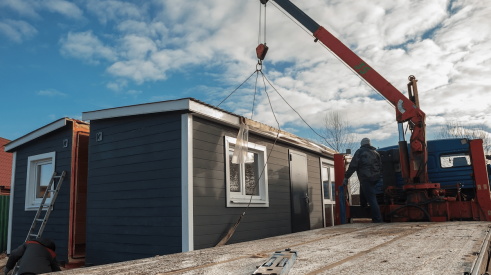|
|||||||||||||||
Termites have survived millions of years and can be found in every state except Alaska. Unfortunately, hot housing markets, especially in the Sun Belt, happen to be the same places huge numbers of termites call home.
A new crop of technologies offers builders a varied arsenal to attack termites before they have a chance to take a bite out of a new home.
Chemical Pre-Treatments
Of the three main categories of termite control for new homes ù chemical pre-treatments, baiting systems and physical barriers ù treating soil with a chemical termiticide before the foundation pour accounts for the lion's share of termite control and usually costs the least. Chemical pre-treatments provide a layer of protection below and around the home's foundation with a chemical that either repels or is immediately poisonous to termites. Termiticides on the market include Talstar and Prevail from FMC, Termidor, Premise (Bayer) and Phantom (BASF).
A drawback to this method of termite control is the possibility of breaches in the chemical barrier ù through regrading, walking on it or movement of earth from one place to another ù after treatment but before pouring the foundation. Greg Baumann, director of technical services for the National Pest Management Association, says builders should work closely with their pest control operator (PCO) to educate crews.
The chemistry of the treatments used today is significantly better than that of older treatments, many of which have been phased out voluntarily, Baumann says. He notes that in addition to an increase in efficacy, they also are safer for the environment.
Because they are so new, little to no research exists documenting the long-term effectiveness of these chemicals, but Baumann says they are expected to perform very well in the long term.
Baiting Systems
Fairly new to termite technology are baiting systems. As with chemical pre-treatments, brands such as Sentricon (Dow AgroSciences), FirstLine (FMC), Exterra (Ensystex) and Outpost (Bayer) vary but work similarly.
Rather than treat an entire area beneath and around a home, baiting systems are composed of stakes or stations inserted directly into the soil at intervals around the house. Depending on the product, these stations might contain a toxicant or untreated food that is replaced with poison once the PCO detects termites.
|
The Sentricon baiting station contains wood. When a pest control operator detects termite activity, he replaces it with bait (a termiticide), which termites carry back and feed to the colony.
|
In the Sentricon System, the PCO monitors the untreated stations for evidence of termites and installs a termiticide in the stations upon discovery of termite activity. Termites carry the bait back to their colony and spread it through feeding and grooming, wiping out the colony. The process starts again with continual monitoring.
Because the bait stations are installed after a home is constructed, baiting systems do not affect cycle times like chemical pre-treatments, which must be applied and allowed to set before the foundation is poured. As with chemical pre-treatments, however, the builder's responsibility ends after a year, when it becomes the homeowner's responsibility to contract with the PCO to continue monitoring and treatment. The system offers no residual protection if the homeowner discontinues service.
Their low toxicity compared with chemical pre-treatments helps sell baiting systems to environmentally minded buyers. Although baiting generally costs more than chemical pre-treatments, some systems are fairly competitive in price. "It's an operational decision rather than a financial one," Baumann says.
Physical Barriers
Physical barriers, namely Termimesh and Impasse (Syngenta), are perhaps the most intriguing new termite technology.
Termimesh is a fine stainless steel mesh that termites cannot penetrate. (Termites can get through an opening as small as 1/64 inch.) Stainless steel clamps attach the mesh to plumbing, electrical and drain penetrations before the foundation is poured. The mesh also is attached where wood framing touches the slab, around the perimeter and in control joints between concrete pours ù all of which are areas termites consider superhighways to a feast. The system also features specialized cement that bonds the mesh to concrete or masonry.
|
The Impasse barrier, a polymer sheet with termiticide locked inside, covers the home's footprint. Special boots fit around plumbing penetrations and then are heat-seamed to the barrier.
|
The Impasse Termite System consists of a unique construction-grade polymer sheet that is laid before the slab pour, much like a vapor barrier.
The sheet is composed of two layers of polyethylene film fused together with an insecticide locked between them. The crew rolls it out in long strips to cover the home's footprint, including exterior footings, and then heat-seams the panels together. Specially designed boots go around the penetrations (which come up through a hole cut in the barrier) and are heat-seamed to the rest of the barrier.
Both Impasse and Termimesh have notable warranties. Impasse is guaranteed for an unheard-of 10 years, and Termimesh has a three-year, $250,000 warranty. Both present an extremely green alternative as well, and although they cost more upfront, no reapplication is necessary. Homeowners still should have regular inspections, however.
The Impasse line recently expanded to include Termite Blockers, which wrap the penetrations like the boots, but the blockers then are embedded in a concrete slab. Much less expensive than a complete system, the blockers complement other termite treatments.
Bora-Care
A product that does not quite fit into the other categories is wood treated with a chemical distasteful to termites. Bora-Care, from Nisus Corp., differs in that the PCO applies it to the wood framing members at the dried-in phase of construction, after roofing but before insulation.
The liquid is sprayed onto wood in a 2-foot band where the wood touches concrete, as well as at all penetrations. So where a wall meets the floor, Bora-Care goes 2 feet up the wall and 2 feet away from the wall on the foundations. The chemical soaks into and through the wood, making it unpalatable to termites. According to Nisus, the product does not break down and lasts the lifetime of the wood.
The PCO can apply it with a portable tank and sprayer while other workers are in the house, so it does not disrupt the building cycle. Pricing varies widely depending on the linear footage of wood that needs to be treated. In an area with Formosan termites, the framing of the entire structure must be sprayed.
Only licensed PCOs should apply or install these termite control systems. Baumann adds that builders should be sure the PCO is insured and follows all regulatory requirements and manufacturer directions for each product. Baumann also encourages builders to work as closely as possible with PCOs and the pest control industry.
The NMPA has set up a forum on its Web site, www.pestworld.org, where builders can post specific pest control questions and receive answers from NMPA professionals.
Advertisement
Related Stories
Off-Site Construction
Utah Passes Bill to Regulate Modular Construction at the State Level
Goals for housing innovation and affordability meet in Utah's passage of a new bill that establishes a statewide modular construction program
Awards
Ivory Innovations Announces 25 Finalists for the 2024 Ivory Prize
The finalists for the prize demonstrate innovative, scalable solutions for advancing housing affordability
Business Management
AI in Home Building ... What Now? What Next?
Artificial intelligence is coming to home building. How can builders use AI in new-home construction? Start with this primer






